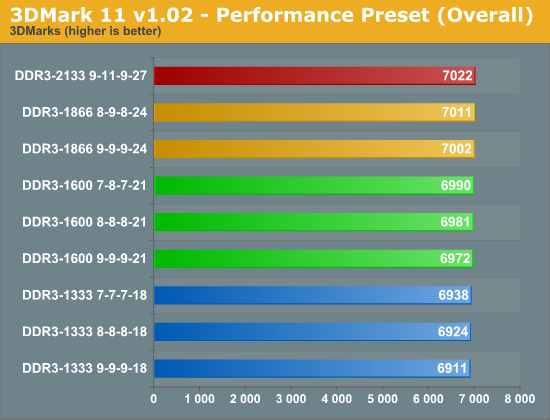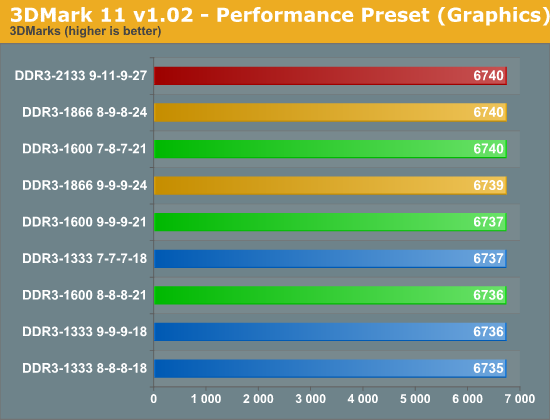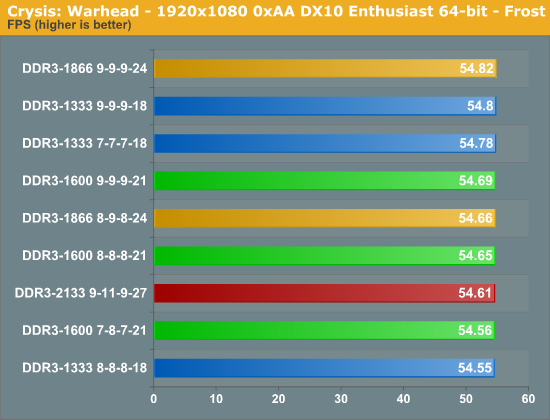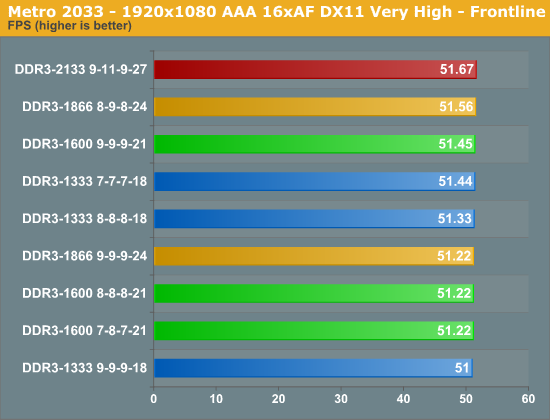Sandy Bridge Memory Scaling: Choosing the Best DDR3
by Jared Bell on July 25, 2011 1:55 AM EST3DMark 11
We're going to start the graphics benchmarks with the synthetic 3DMark test. The latest version, 3DMark 11, is still very GPU dependent. However, it does include a CPU Physics test and a combined graphics/physics test for simulating those types of loads. We’ll use the overall score with the three subtests to see if we can find any areas where memory performance makes a noticeable difference.




The overall score, which is heavily based on the graphics tests, shows a mere ~1% change across the board. When you get to the graphics test, you can see that the faster memory makes absolutely no difference at all. It's not until we get to the physics test where we see some improvement from increasing the memory speed. We get performance boost of up to 11% when going from DDR3-133 to DDR3-2133. The combined test entails the rendering of a 3D scene with the GPU while performing physics tasks on the CPU. Here again, were see a very small 2% increase in performance from the slowest to the fastest.
Crysis and Metro 2033
Based on 3DMark 11, then, we’d expect most games to show very little improvement from upgrading your memory, but we ran several gaming benchmarks just to be sure. I decided to combine the analysis for Crysis: Warhead and Metro 2033 due to the virtually non-existent differences observed during these tests. Crysis: Warhead was the previous king of the hill when it came to bringing video cards to their knees. The newer kid on the block, Metro 2033, has somewhat taken over that throne. Just how do they react to the various memory configurations we're testing today?
It's worth noting that the settings used here are the settings that I would actually play these games at: 1920x1080 with most of the high quality features enabled. Frame rates are well above 30, so definitely playable, though they’re below 60 so some would say they’re not perfectly smooth. Regardless, unless you play at settings where your GPU isn’t the primary bottleneck, you should see similar scaling from memory performance.


The results weren't very stimulating, were they? Just as expected, gaming with faster memory just doesn't make any notable difference. I could have potentially lowered the resolution and settings in an attempt to produce some sort of difference, but I felt that testing these games at the settings they're most likely to be played at was far more enlightening. If you want better gaming performance, the GPU is the best component to upgrade—no news there.










76 Comments
View All Comments
Rajinder Gill - Friday, July 29, 2011 - link
LOL!Caught with your pants down there sir.
Isaac the k - Tuesday, August 2, 2011 - link
Memory above DDR3-1333 is plentiful and cheap.Sandy Bridge benefits from the bump up to 1600.
Mobo's all can handle the higher spec'ed memory.
WHY IS INTEL SPEC'ING THE NEW I7's FOR 1333 INSTEAD OF 1600 BY DEFAULT?
I don't want to have to futz with my BIOS just to get my memory to run at STOCK timings!
Why the HELL are they crippling the basic utility of their chips??
I grant you, it isn't a major increase in performance, but why set the ceiling so low? why not set it higher and let the mobo manufacturers choose what their boards are compatible with???
shriganesh - Wednesday, August 24, 2011 - link
This article is thoughtful and very good news for mid-end to high-end system builders :)There's absolutely no need to pay extra for those faster and better memory modules!!
ryedizzel - Tuesday, September 20, 2011 - link
Thank you very much for this article. I have been memory shopping for a couple days now and debating on different memory speeds vs. latency vs. price. I wish I had the lab setup to test them all. Thanks again!James D - Monday, November 28, 2011 - link
On each speed type (1333, 1600, 1866 etc.) you used only slightly different timings! For example for speed 1333 Mhz you had:1) 7-7-7-18
2) 8-8-8-18
3) 9-9-9-18
In this case of course you won't get much different results! Don't you know that changing CL and other timings you can change tRAS timings which is the minimum number of clock cycles needed to access a certain row of data in RAM between the data request and the precharge command.
OF COURSE you won't get big difference if you didn't change tRAS! If you lower all other timings then most likely you can decrease tRAS which also will increase performance.
Please rebench all these with slightly different all types of timings. It means a lot for results.
poohbear - Saturday, December 17, 2011 - link
Thanks for running the gaming benchmarks @ 1920x1080 to show us practical results (ie there were none!). i hate it when they run these benchmarks @ 800x600 or some nonsensical low resolution to show us a difference that we really could care less about in 2011.